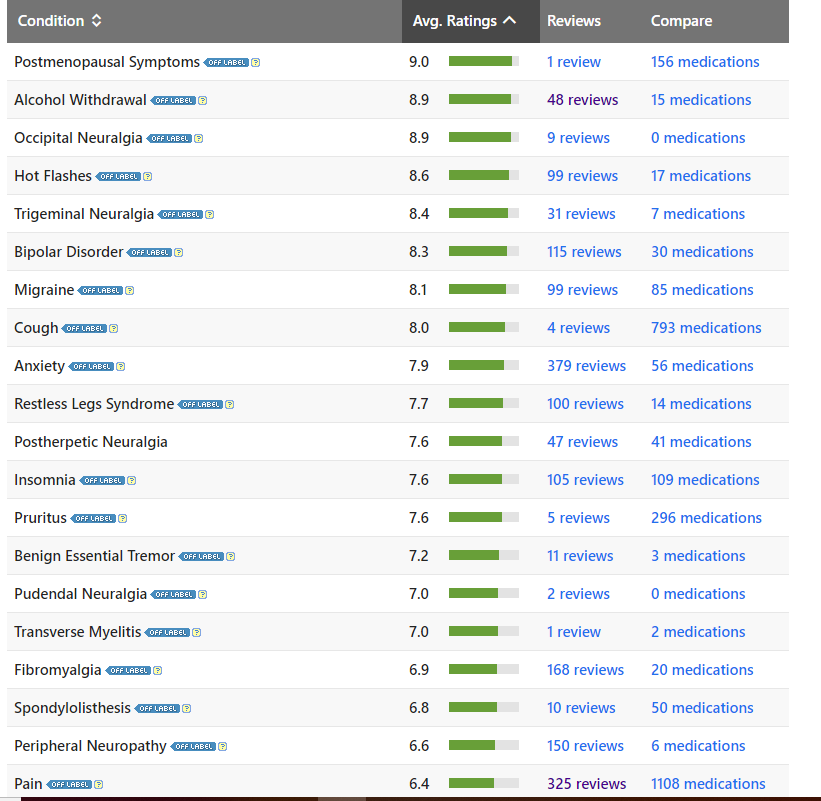The Neurontin brand of gabapentin can be taken with or without food. If you break a 600mg or 800mg Neurontin tablet in half, be sure to take the other half at your next dose or within 28 days.

The Gralise brand of gabapentin cannot be substituted for other gabapentin products due to differing administration requirements (once daily versus three times daily for other products).
Gralise should be taken with food at the evening meal. Gralise tablets should be swallowed whole; do not cut, crush, or chew.
Horizant (gabapentin enacarbil) tablets should be swallowed whole and taken with food. For restless leg syndrome, take at roughly 5 PM in the evening. Do not cut, crush, or chew the tablet. Do not interchange Horizant with other gabapentin products.
Use a manufacturer-provided or pharmacist-provided measuring cup calibrated for liquid formulations when measuring liquid doses of gabapentin. Do not use a kitchen measuring device or teaspoon because these may be inaccurate.
For dosage schedules of three times daily do not allow more than 12 hours between doses.
Monitor for mood changes and report any evidence of new or worsening mood or depression to the prescribing doctor.
Do not take gabapentin at the same time as antacids such as Maalox or Gaviscon. Separate administration by at least two hours. Take exactly as directed by your doctor, do not increase or decrease the dose without his or her advice.
Avoid operating machinery, driving, or performing tasks that require mental alertness if gabapentin makes your drowsy or impairs your judgment.
The side effects of gabapentin, such as dizziness or drowsiness, may increase your risk of falling. Remove any fall hazards from your home if possible (such as loose rugs), and be careful when ascending or descending stairs.
Talk to your doctor if you experience any worsening of your mood or if you develop any suicidal thoughts.
Do not stop taking gabapentin without your doctor’s advice as it may precipitate a withdrawal reaction (symptoms include agitation, disorientation, confusion). When the time comes to discontinue gabapentin your doctor will tell you how to taper it off.
Seek urgent medical advice if you develop a rash, fever, difficulty breathing or facial swelling while taking gabapentin.
Signs of a Gabapentin Addiction
Effects of excessive Gabapentin use include:
-
-
- Drowsiness
- Coordination problems
- Tremors
- Dizziness
- Depression
- Suicidal thoughts/behaviors
- Changes in mood
- Dizziness
- Poor coordination
- Forgetfulness
- Anxiety
- Difficulty speaking
- Inability to feel pleasure
It is important to try to recognize these symptoms and to be wary of other red flags, such as the presence or abundance of pill bottles. These effects can be detrimental to one’s health, livelihood, and overall safety.
Many Gabapentin users in early recovery abuse Gabapentin because at high doses (800mg or more), they may experience a euphoric-like high that does not show up on drug screens. Gabapentin abusers typically take the drug in addition to opioids to produce their desired high, a dangerous and potentially deadly combination. It is possible to fatally overdose on Gabapentin, both on its own or in conjunction with other drugs. However, there is currently no antidote that can be administered to someone in the case of a Gabapentin overdose as there is with opioid overdoses. If you find a loved one showing signs of an overdose–drowsiness, muscle weakness, lethargy and drooping eyelids, diarrhea, and sedation—seek medical attention immediately.
Signs of Gabapentin Addiction
-
-
- Lying about or exaggerating symptoms to doctors
- Seeking out multiple doctors to get extra doses
- Switching doctors after the original doctor refuses to continue prescribing the medication
- Changes in social habits and/or circles
- Changes in personal hygiene and grooming habits
- Constant preoccupation with the drug
- Unease at the thought of the drug being unavailable
- Refusal to quit despite social, financial, or legal consequences
- Failed attempts to quit
Treating a Gabapentin Addiction
Frequent and excessive use of Gabapentin can lead to a physical and psychological dependence on the drug.

This is when someone becomes so accustomed to taking a drug that they need it to feel and function normally. Quitting a drug like Gabapentin cold turkey can be dangerous and induce several withdrawal symptoms of varying severity.
These include anxiety, insomnia, nausea, pain, and sweating. Quitting also increases one’s likelihood of having a seizure which can lead to personal injury or the development of medical problems and life-threatening emergencies.
Trying to quit should be done at a rehab facility or with the guidance and supervision of a professional during a medical detox.





